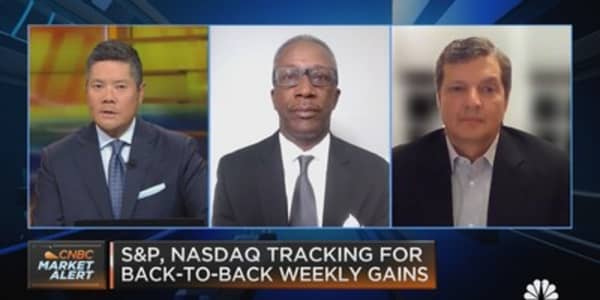Robo-advisors have made one thing abundantly clear to traditional financial advisors: Picking investments for clients is simply not enough anymore.
"Investments are table stakes now," said certified financial planner Erin Wood, vice president of wealth planning at Carson Group Holdings in Omaha, Nebraska. "Advisors have to help clients across a whole spectrum of needs and objectives.
"If they aren't providing financial planning, their clients will get it somewhere else."
The idea of "holistic financial planning" has been around for some time, most particularly in the fee-based registered investment advisor community. However, there is a big difference between promising that kind of service and actually delivering it. Increasingly, advisors are turning to sophisticated and accessible financial-planning software to deliver on the promise.
More from FA Playbook:
Are advisors prepared for cyberattacks?
Firms like Morgan Stanley turn to A.I. to advise investors
Blockchain technology's potential will keep spurring investment
"Advisors have had financial-planning software for a while, but I think they're starting to use it more," said south Florida-based CFP and consultant Joel Bruckenstein.
Head of T3 Consulting Services, which helps advisors understand and adapt to technology trends in the wealth management industry, Bruckenstein conducts an annual survey of thousands of advisors on the software tools they use.
"A lot of advisors give lip service to the idea of financial planning, but the biggest change I see in the last two or three years is the reemergence of financial-planning software," he said.
Bruckenstein's latest survey bears out the idea. To that point, 64% of the more than 5,500 respondents to this year's survey said they were using financial-planning software. The usage rates are, not surprisingly, highest for fee-only advisors (68.3%), compared to dually registered advisors (60.6%) and brokerage and wirehouse advisors (44%).
ADVISORS USING FINANCIAL-PLANNING SOFTWARE
| Percentage of users | |
| EXPERIENCE | |
| 1-5 years | 55.07% |
| 6-10 years | 59.63% |
| 20+ years | 63.57% |
| FIRM SIZE | |
| < $200K | 62.62% |
| $200K-$500K | 64.85% |
| $500K-$1M | 60.37% |
| $1M-$1.5M | 65.47% |
| $1.5M-$2M | 64.37% |
| $2M-$3M | 61.46% |
| $3M-$4M | 64.84% |
| $4M-$5M | 69.78% |
| $5M-$8M | 69.83% |
| > $8M | 52.29% |
| REVENUE MODEL | |
| Fee-only | 68.27% |
| Dually registered | 60.57% |
| Brokerage/wirehouse | 44.06% |
Source: T3 Consulting Services
Larger firms tended to use the software more than smaller ones and 63.6% of advisors with 20-plus years of experience use it, compared to 55.1% of those with less than five years of experience.
When asked what software tools were the most valuable to their practices, customer relationship management applications ranked first, at 52.3%. Financial-planning software came in second at 22.9%, almost twice the number who said portfolio management software.
The software is powerful. The most comprehensive products of market leaders MoneyGuidePro and eMoney, which account for more than 50% of the market, cover virtually every aspect of a person's financial life.
They present value pension payouts and other future income streams. They assess different Social Security filing strategies, project future health-care expenditures, determine debt-management options, optimize tax planning and retirement distribution scenarios. And they do it incorporating assumptions about a person's risk tolerance and the potential returns from an investment portfolio.
If you call yourself a financial planner, you should be using this software.Joel Bruckensteinpresident, T3 Consulting Services
"Financial-planning software is an easy way for advisors to develop deeper relationships with their clients," said Danielle Fava, director of product strategy at TD Ameritrade Institutional, which serves as custodian for more than 7,000 advisors. "It enables all kinds of advisors to do good planning."
Typically, financial-planning software has been used to help people planning for retirement and not as much for younger clients. That's no longer the case.
"There's been a shift in the industry," Carson's Wood said. "The software was built around the goal of retirement and now it's opened up across the whole spectrum of financial planning.
"Advisors can help every client with the tools now."
Wood's goal at Carson is to tie in optional tools to the core IT systems that all the firm's advisors are required to use. Financial planning is one of those optional tools.

"The more tools we tie in, the greater the usage rate by our advisors," she said. Wood estimates that between 50% and 60% of the approximately 224 advisors working in Carson Partners offices now use financial-planning software. By comparison, she estimates the overall industry has a usage rate at about 20%.
While the most comprehensive financial-planning software can incorporate a staggering number of variables and assumptions and can present a host of options for clients to achieve their objectives, bigger is not always better, according to Sheryl Garrett, CFP and founder of Garrett Planning Network, which has 250 advisor members.
The objective of the tools is to help advisors make better connections with their clients.
"The biggest flaw in financial-planning software comes from too much data entry," Garrett said. "Most of the clients we work with are average Americans and what they need is a simple, straightforward projection tool.
Financial-planning software is an easy way for advisors to develop deeper relationships with their clients.Danielle Favadirector of product strategy, TD Ameritrade Institutional
"You want a solution that narrows down the range of possible outcomes."
She also thinks that huge financial plans covering every variable and aspect of an individual's financial future can be a burden for younger clients. For a more limited goals-based planning approach, advisors may not need to model Social Security filing strategies or map out the effects of insurance on a client's financial position.
"Modeling for retirement makes sense when the time horizon is nearer, but the range of outcomes can be huge when the time span is large," Garrett explained. "For a 20-year-old client, you want something quick and clear and you want to be planning for the next 10 years of their lives."
A favorite tool of Garrett's is Goalgami, a web-based software solution that doesn't cover the huge range of variables that the big applications such as eMoney or MoneyGuidePro offer.
"It's great for simplistic savings goals, like financing college for your kids or planning a vacation," she said. "It produces a nice short report to share with clients."
Wood agrees that effectively harnessing the enormous power of financial-planning software is about engaging clients and helping them commit to a plan to achieve their goals.
"The objective is to produce reports with impact that don't overload the client and give them things they can act on," she said. "Planning software can be a crutch or it can be a tool.
"If an advisor is just using it to solve math problems, it's a crutch," Wood added. "If they use it to show clients options and a path to achieving their goals, it's a valuable tool."
Financial planning is a process, not a product, advisors say.
Financial plans and goals change as people's lives change and the role of advisors is to help their clients adjust to changing circumstances to meet those goals. Advisors are increasingly using technology to do just that.
"If you call yourself a financial planner, you should be using this software," Bruckenstein said.




